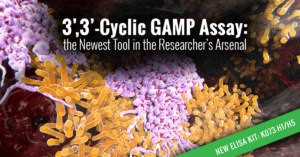3′,3′-Cyclic GAMP Assay: The Newest Tool in the Researcher’s Arsenal
 Cyclic dinucleotides are the most abundant second messengers in bacteria, modulating a variety of cellular activities in prokaryotic cells. 3’3’-cyclic GAMP (cyclic [G(3’,5’)pA(3’,5’)p], previously known as cGAMP) is a key mediator of bacterial signal transduction and regulation, controlling a range of diverse targets including transcription, enzyme activity and cell cycle progression. 3’3’-cGAMP signaling in bacteria is regulated in-part by gene regulatory RNA elements called riboswitches that bind and respond to cGAMP with high affinity and specificity. The 3’3’-cGAMP riboswitches regulate genes involved in motility, biofilm formation, colonization, and virulence. The cyclic dinucleotides have emerged as key central regulators of bacterial physiology and inhibition studies of cGAMP signaling as an anti-microbial strategy are ongoing.
Cyclic dinucleotides are the most abundant second messengers in bacteria, modulating a variety of cellular activities in prokaryotic cells. 3’3’-cyclic GAMP (cyclic [G(3’,5’)pA(3’,5’)p], previously known as cGAMP) is a key mediator of bacterial signal transduction and regulation, controlling a range of diverse targets including transcription, enzyme activity and cell cycle progression. 3’3’-cGAMP signaling in bacteria is regulated in-part by gene regulatory RNA elements called riboswitches that bind and respond to cGAMP with high affinity and specificity. The 3’3’-cGAMP riboswitches regulate genes involved in motility, biofilm formation, colonization, and virulence. The cyclic dinucleotides have emerged as key central regulators of bacterial physiology and inhibition studies of cGAMP signaling as an anti-microbial strategy are ongoing.
In mammalian cells, 3’3’-cGAMP and its eukaryotic analog 2’3’-cGAMP produced by cGAS, bind STING (stimulator of IFN genes) and subsequently induce TBK1-IRF3-dependent production of IFN-β. Here, the cGAS-cGAMP-STING DNA sensing pathway is a key activator of the innate immune response to foreign or harmful native DNA. The cGAS-cGAMP-STING pathway plays a critical role in antiviral and antitumor immunity as well as mediating autoimmune responses. Dysregulation or aberrant activation of the pathway by self-DNA has emerged as an underlying cause of tumorigenesis and autoimmune disorders.
As the critical role of cyclic dinucleotides in pathophysiology continues to emerge, new tools to study these signaling pathways are being developed. Arbor Assays developed the first immunoassay for measuring 2’3’-cGAMP (K067-H1/H5, H1D) in model systems of STING activation. A recent study by Volkman et.al. cites the use of this 2’3’-cGAMP ELISA to analyze nuclear cGAS binding motifs. The newest assay, 3′,3′-Cyclic GAMP ELISA (K073-H1/H5), accurately quantifies 3’3’-cGAMP in bacterial or eukaryotic cell lysates using a simple and convenient ELISA format. These innovative and valuable tools will facilitate further understanding of the role cyclic dinucleotides play in health and disease.
